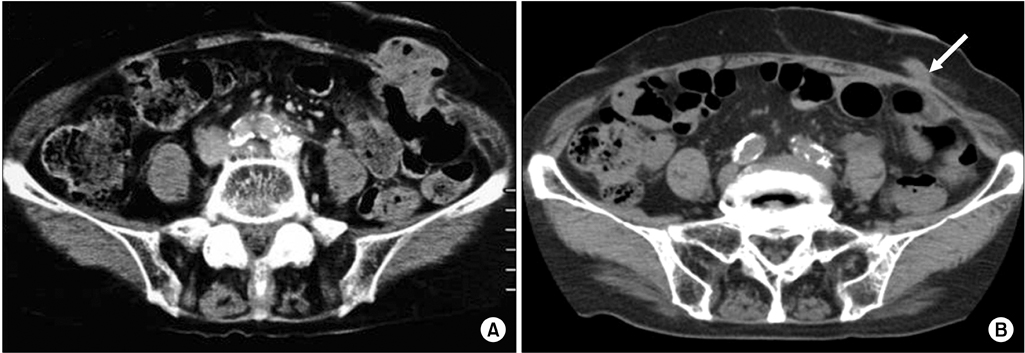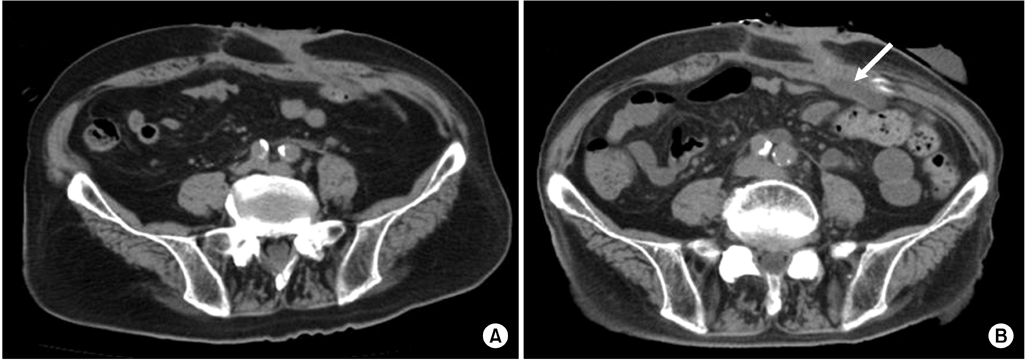Korean J Urol.
2013 Mar;54(3):168-171.
Evaluations for Hydronephrosis After the Establishment of Tubeless Cutaneous Ureterostomy
- Affiliations
-
- 1Department of Urology, Kohka Public Hospital, Kohka, Japan. cj-kim@belle.shiga-med.ac.jp
Abstract
- PURPOSE
To investigate hydronephrosis after the establishment of tubeless cutaneous ureterostomy by using our definition of the tubeless condition and our indications for catheter insertion.
MATERIALS AND METHODS
Twenty-eight (54 renal units) patients with both establishment of tubeless cutaneous ureterostomy 3 months after surgery and at least 12 months of follow-up were investigated in this study. The 4-grade system was used to evaluate the hydronephrosis. The definition of the tubeless condition in cutaneous ureterostomy was as follows: 1) the catheter stent is not placed in the renal pelvis through the stoma, 2) the grade of hydronephrosis is less than 3, and 3) the kidney is functioning. Indications for catheter insertion after the establishment of tubeless cutaneous ureterostomy were as follows: 1) difficulty in curing acute pyelonephritis by drug treatments, 2) flank pain due to hydronephrosis, or 3) increase in the grade of hydronephrosis.
RESULTS
The follow-up period was 12 to 78 months (average, 40.5+/-22.1 months). After the establishment of tubeless cutaneous ureterostomy, 6 of 54 renal units (11.1%) were eligible for catheter insertion. The catheter insertion was performed in 4 renal units. Another 2 renal units were followed up without intervention, and they gradually became atrophic. The renal functions were preserved in the other 52 renal units.
CONCLUSIONS
Our results suggest that our definition of the tubeless condition and our indications for catheter insertion would be useful for the evaluation and management of hydronephrosis after establishment of tubeless cutaneous ureterostomy.
Keyword
MeSH Terms
Figure
Reference
-
1. Williams O, Vereb MJ, Libertino JA. Noncontinent urinary diversion. Urol Clin North Am. 1997. 24:735–744.2. Hirokawa M, Iwasaki A, Yamazaki A, Asakura S, Nozaki A, Yamagishi T. Improved technique of tubeless cutaneous ureterostomy and results of permanent urinary diversion. Eur Urol. 1989. 16:125–132.3. Ariyoshi A, Fusijawa Y, Ohshima K, Hiratsuka Y, Sakamoto K. Catheterless cutaneous ureterostomy. J Urol. 1975. 114:533–535.4. Toyoda Y. A new technique for catheterless cutaneous ureterostomy. J Urol. 1977. 117:276–278.5. Rainwater LM, Leary FJ, Rife CC. Transureteroureterostomy with cutaneous ureterostomy: a 25-year experience. J Urol. 1991. 146:13–15.6. Namiki T, Yanagi S. A new technique for bilateral single stoma loop cutaneous ureterostomy. J Urol. 1995. 154(2 Pt 1):361–363.7. Kim CJ, Wakabayashi Y, Sakano Y, Johnin K, Yoshiki T, Okada Y. Simple technique for improving tubeless cutaneous ureterostomy. Urology. 2005. 65:1221–1225.8. Straffon RA, Kyle K, Corvalan J. Techniques of cutaneous ureterostomy and results in 51 patients. J Urol. 1970. 103:138–146.9. Kim CJ, Takimoto K, Tomita K, Osafune T, Nishikawa N, Johnin K, et al. Evaluation of hydronephrosis with tubeless cutaneous ureterostomy using Tc-99m MAG3 diuretic renography. Clin Nucl Med. 2009. 34:666–669.10. Rodriguez AR, Lockhart A, King J, Wiegand L, Carrion R, Ordorica R, et al. Cutaneous ureterostomy technique for adults and effects of ureteral stenting: an alternative to the ileal conduit. J Urol. 2011. 186:1939–1943.11. Talner LB. Pollack HM, editor. Obstructive uropathy. Clinical urography. 1990. Philadelphia: W.B. Saunders;1535–1751.12. McGrath A, Porrett T, Heyman B. Parastomal hernia: an exploration of the risk factors and the implications. Br J Nurs. 2006. 15:317–321.
- Full Text Links
- Actions
-
Cited
- CITED
-
- Close
- Share
- Similar articles
-
- Diagnostic Criteria for Stomal Obstruction of Tubeless Cutaneous Ureterostomy by Use of 99mTc-Mercaptoacetyltriglycine Diuretic Renography
- A clinical experience of urinary diversion: postoperative complications of diversion
- Experiences with Cutaneous Transureteroureterostomy
- Clinical Observation of Antegrade Pyelography
- A Patient with Hinman's Syndrome who Underwent Renal Transplantation Using a Pre-existing Cutaneous Ureterostomy



